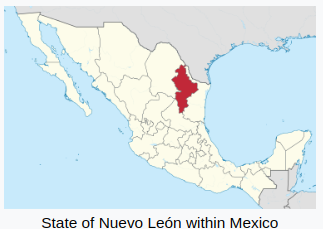Credit Wikipedia
#18,424
Although two recent human H5 infections in Mexico currently have our attention, our Southern neighbor has a long history of dealing with both LPAI and HPAI H5 and H7 viruses. In 2024, Mexico reported roughly 20 outbreaks of HPAI H7N3 (see WAHIS Report).
While large outbreaks of H7 in Mexico have declined the past few years, in 2012-2013 H7N3 forced the culling of more than 22 million birds leading Mexico To Declare a National H7N3 Animal Health Emergency. An emergency H7 vaccination campaign was ordered first in the hardest hit states, and then later expanded to encompass much of the country.
In 2019's PLoS One: Rapid Evolution of Mexican H7N3 HPAI Viruses In Poultry, the authors noted that while vaccination had greatly reduced the impact of H7N3, it had not eliminated the virus completely. They wrote:
This vaccine although protective early on, appeared to have reduced effectiveness after just a few years. Although a direct association between H7N3 vaccination and virus evolution has not been fully established, there is evidence that addition of N-glycosylation sites contributed to the escape of 2015 Mexican H7N3 HPAI from vaccine-induced immunity [16].
In addition, considering that the AI virus evolves more rapidly in domestic poultry than in wild birds, the high evolution rate and dn/ds ratio of HA in the Mexican poultry viruses, which is comparable to the rate of Italian H7N1 and Indonesian H5N1 outbreaks, may also imply selective pressure caused by vaccine-induced immunity [40, 48].
A more recent (2022) study - Phylogenetic Inference of the 2022 Highly Pathogenic H7N3 Avian Influenza Outbreak in Northern Mexico - found that 10 years after the 2012 outbreak, Mexico's H7N3 virus had diversified into 5 phylogenetically distinct clusters.
The authors noted:
Despite the implementation of vaccination, biosecurity, and surveillance measures, the identification of H7N3 HPAIV has expanded from its initial detection in the state of Jalisco in 2012 to an additional 15 states by 2021 (https://wahis.woah.org/#/dashboards/qd-dashboard, accessed on 7 September 2022).
Although H7 poultry vaccine used by Mexico had been reportedly updated 5 times over those 10 years, the authors cautioned:
A total of 18 amino acid alterations were observed when compared with the inactivated vaccine, whereas 14 amino acid changes were found when compared with the recombinant vector vaccine. This suggests that the current vaccines need to be reevaluated for their protective efficacy against the 2022 HPAI H7N3 strains.
A reminder that while poultry vaccinations can greatly reduce poultry losses, they are not a `fire and forget' weapon. They must be carefully applied, continually updated, and flocks need to be closely monitored for silent infections and new emerging variants.
Yesterday's translated announcement from the SENASICA follows:
Activates Agriculture health protocol in Marín, Nuevo León in the presence of avian influenza on a commercial farm
Senasica immediately implemented the corresponding measures to contain the outbreak
National Service of Health, Safety and Agri-Food Quality | April 17, 2025 | Statement
The Ministry of Agriculture and Rural Development (Agriculture), through the National Service of Health, Safety and Agri-Food Quality (Senasica), confirmed the detection of the avian influenza virus AH7N3 in a commercial farm located in the municipality of Marín, Nuevo León, which is different from the one that is affecting poultry farms in other North American countries and does not represent any risk for the consumption of chicken and eggs.
Senasica immediately implemented the corresponding counter-epidemic measures to contain the outbreak. As part of the follow-up, technical personnel carry out constant monitoring in the peripheral area (10 km around), as well as sampling on farms located within the focal area.
Senasica reiterates its call to poultry producers, both commercial and family, to reinforce biosecurity measures in their Poultry Production Units (UPA). Among the main recommendations are:
● Avoid the entry of wild birds or harmful fauna at all times.
● Prevent access for people outside the UPA.
● Thoroughly review the facilities to avoid possible entry points.
● Ensure staff bathe before entering and leaving the farm.
● Change house clothes for work clothes before entering and vice versa.
Senasica invites producers, as well as veterinary doctors and doctors to report any suspicions to the telephone number 800 751 2100, WhatsApp 55 36 96 44 62, or in any AGRICULTURE office, Senasica or the Coordination of the Directorate of the Mexico-United States Commission for the Prevention of Foot-and-Mouth Disease and Other Exotic Animal Diseases (CPA) in the states.
While most notorious for their ability to cause great damage in poultry flocks, avian H7 viruses have shown some ability to infect humans as well. Beyond the obvious example of > 1600 H7N9 infections in China:
- In December of 2016, at least two veterinarians caring for sick cats at a NYC shelter were mildly infected with H7N2 (see J Infect Dis: Serological Evidence Of H7N2 Infection Among Animal Shelter Workers, NYC 2016).
- 3 mild cases were reported in Italy in 2013 (see ECDC Update & Assessment: Human Infection By Avian H7N7 In Italy).
- Mexico reported a couple of mild human H7N3 infections back in 2012 (see MMWR: Mild H7N3 Infections In Two Poultry Workers - Jalisco, Mexico), resulting in conjunctivitis without fever or respiratory symptoms.
While far less common than H5, the United States has reported sporadic outbreaks of H7, including an outbreak of H7N3 in 2020 (see USDA/APHIS Confirm HPAI H7N3 In South Carolina Turkey Flock).
